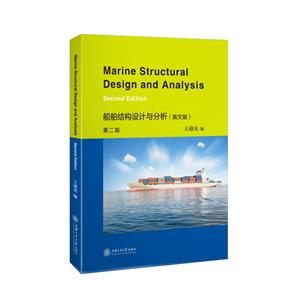掃一掃
關注中圖網
官方微博
本類五星書更多>
-
>
公路車寶典(ZINN的公路車維修與保養秘籍)
-
>
晶體管電路設計(下)
-
>
基于個性化設計策略的智能交通系統關鍵技術
-
>
花樣百出:貴州少數民族圖案填色
-
>
山東教育出版社有限公司技術轉移與技術創新歷史叢書中國高等技術教育的蘇化(1949—1961)以北京地區為中心
-
>
鐵路機車概要.交流傳動內燃.電力機車
-
>
利維坦的道德困境:早期現代政治哲學的問題與脈絡
船舶結構設計與分析(英文版 第2版) 版權信息
- ISBN:9787313235015
- 條形碼:9787313235015 ; 978-7-313-23501-5
- 裝幀:一般膠版紙
- 冊數:暫無
- 重量:暫無
- 所屬分類:>>
船舶結構設計與分析(英文版 第2版) 內容簡介
《船舶與海洋結構物結構設計與分析》的特點是概念闡述簡明清晰,理論推導嚴密詳盡,并穿插配合工程應用實例說明,目的是使學生通過工程應用實例來加深對船舶與海洋結構物結構設計與分析基本原理和基本概念的理解,以期收到事半功倍的效果。??《船舶與海洋結構物結構設計與分析》的重點是以結構靜力學和動力學為基礎,研究船舶與海洋結構物結構設計與分析的外載荷計算、結構動力響應、結構規范設計、結構直接計算法設計等。
船舶結構設計與分析(英文版 第2版) 目錄
Chapter 1 Introduction to marine structural design
1.1 The traditional design method
1.1.1 The evolutionary process
1.1.2 A ship structural design example
1.1.3 The changes to the traditional design method
1.2 The modern design method
1.2.1 The first-principles-based approach
1.2.2 The design procedure
1.2.3 Benefits of the modem approach
Chapter 2 Marine structural design fundamentals
2.1 Structural arrangement design
2.1.1 Subdivision arrangement
2.1.2 Compartment arrangement
2.1.3 Access arrangement
2.2 Structural materials
2.2.1 Introduction to materials
2.2.2 Standard steels used for hull and other structure
2.2.3 High strength steel used for hull and other structures
2.2.4 Selection for steel grades
2.2.5 Other ship materials
2.2.6 An example of ship materials used for a dredging barge
2.3 Welding
2.3.1 The base types of welding joints
2.3.2 The base types of welding line
2.3.3 Stud welding
2.3.4 The determination of the weld size
2.3.5 A welding design example
2.4 Classification societies and their rules
2.4.1 Classification societies
2.4.2 Class rules, regulations and guides
Chapter 3 Loads and loads combinations
3.1 Environmental considerations
3.2 Loads
3.2.1 Static loads
3.2.2 The wave induced loads
3.2.3 The hydrodynamic loads
3.2.4 The sloshing loads
3.2.5 The impact loads
3.2.6 Other loads types
3.3 Loads combinations
3.4 Strength modeling and development of strength criteria
Chapter 4 Marine structural initial design
4.1 Hull girder strength and sheafing strength
4.2 Hull structural members design
4.2.1 Hating design
4.2.2 Longitudinals and girders design
4.2.3 Bulkhead design
4.3 An example of hull structural members design-pillar design
4.3.1 Basic design of pillars
4.3.2 Some requirements for the pillars in rules
4.3.3 Regulations of pillars on different types of ships
4.4 Superstructure design
4.4.1 The interaction between the superstructure and the main hull
4.4.2 The design of superstructures
4.4.3 The failure of superstructures and prevention measures
4.5 Introduction to structures of various kinds of ships
4.5.1 Oil tankers
4.5.2 Bulk carriers
4.5.3 Container ships
Chapter 5 Marine structural design analysis
5.1 Total strength assessment
5.1.1 Yielding strength
5.1.2 Buckling and ultimate strength
5.1.3 Fatigue strength
5.2 Strength criteria
5.2.1 General introduction
5.2.2 Yielding criteria
5.2.3 Buckling and ultimate strength criteria
5.2.4 Fatigue criteria
5.3 Finite element analysis
5.3.1 The developmental history of the finite element analysis
5.3.2 The basic idea of the finite element method
5.3.3 A finite element analysis example -- a 75,000 DWT bulk carrier
5.4 Spectral fatigue analysis of ship structures
5.5 The transverse strength analysis of a ship
5.5.1 Setting the design load
5.5.2 Simplification of members' geometry size
5.5.3 Simplification of the frame supporting conditions
5.5.4 Modeling the structure processing
5.5.5 Modeling the loads
5.5.6 Building the finite element model for the ship structures
Chapter 6 Marine structural design optimization
6.1 The introduction to the optimization
6.2 The categorization methods for optimization problems
6.2.1 Continuous versus discrete optimization
6.2.2 Constrained and unconstrained optimization
6.2.3 Global and local optimization
6.2.4 Deterministic and stochastic optimization
6.3 An example--the optimization of stiffened panels
6.3.1 Introduction to stiffened plates
6.3.2 The numerical solution method for a stiffened panel
6.3.3 Summarization
6.4 Another example--the optimization of a T-bar
6.4.1 The problem raised and the model established
6.4.2 Analytical solution method
6.4.3 Finite element analysis solution method
6.4.4 Comments on each solution method
References
展開全部
船舶結構設計與分析(英文版 第2版) 作者簡介
王迎光:上海交通大學碩士導師,長期從事海洋工程隨機結構動力學; 船舶非線性動力學; 船舶結構優化設計研究。
書友推薦
- >
朝聞道
- >
二體千字文
- >
我與地壇
- >
小考拉的故事-套裝共3冊
- >
名家帶你讀魯迅:朝花夕拾
- >
伯納黛特,你要去哪(2021新版)
- >
龍榆生:詞曲概論/大家小書
- >
中國人在烏蘇里邊疆區:歷史與人類學概述
本類暢銷
















